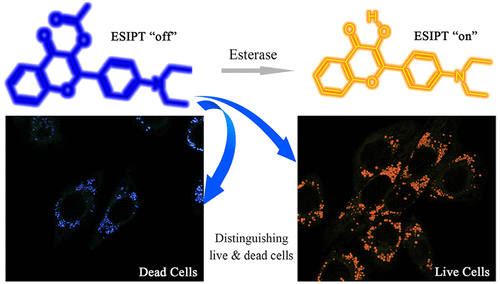当前位置:
X-MOL 学术
›
Anal. Chem.
›
论文详情
Our official English website, www.x-mol.net, welcomes your feedback! (Note: you will need to create a separate account there.)
Discriminating Live and Dead Cells in Dual-Color Mode with a Two-Photon Fluorescent Probe Based on ESIPT Mechanism
Analytical Chemistry ( IF 6.7 ) Pub Date : 2017-12-20 00:00:00 , DOI: 10.1021/acs.analchem.7b04252 Minggang Tian 1 , Jie Sun 1 , Yonghe Tang 1 , Baoli Dong 1 , Weiying Lin 1
Analytical Chemistry ( IF 6.7 ) Pub Date : 2017-12-20 00:00:00 , DOI: 10.1021/acs.analchem.7b04252 Minggang Tian 1 , Jie Sun 1 , Yonghe Tang 1 , Baoli Dong 1 , Weiying Lin 1
Affiliation

|
Discrimination of live and dead cells is an important task in biological, pathological, medical, and pharmaceutical studies. In this work, we have developed a novel fluorescent probe DACA that can discriminate live and dead cells in a dual-color mode for the first time. DACA can stain dead cells with blue fluorescence peaked at 440 nm, while it can also label live cells with orange emission peaked at 570 nm. Compared with one-color fluorescent probes, such a dual-color probe can efficiently avoid false positive results from cellular autofluorescence and misleading signals brought by inhomogeneous staining, and thus can supply more accurate information in biological applications. By means of DACA, the health status of tumor cells pretreated by H2O2 and ultraviolet radiation has been successfully detected and imaged. Moreover, DACA and the hydrolyzed product exhibit excellent two-photon properties. Live and dead cells, as well as the zebrafishes, have been discriminated with dual emission colors under one- and two-photon microscope. These results demonstrate that DACA is a powerful tool for dual-color distinguishing live and dead cells in vitro and in vivo.
中文翻译:

基于ESIPT机制的双光子荧光探针在双色模式下区分活细胞和死细胞
区分活细胞和死细胞是生物学,病理学,医学和药学研究中的重要任务。在这项工作中,我们开发了一种新颖的荧光探针DACA,该探针可首次以双色模式区分活细胞和死细胞。DACA可以用440 nm处的蓝色荧光对死细胞进行染色,同时还可以用570 nm处的橙色发射对活细胞进行标记。与单色荧光探针相比,这种双色探针可以有效地避免细胞自发荧光产生的假阳性结果和不均匀染色带来的误导信号,因此可以在生物学应用中提供更准确的信息。通过DACA,H 2预处理的肿瘤细胞的健康状况。O 2和紫外线已被成功检测并成像。此外,DACA和水解产物显示出优异的双光子性质。在一光子和两光子显微镜下,活细胞和死细胞以及斑马鱼已被双重发射颜色区分。这些结果表明,DACA是用于在体外和体内双色区分活细胞和死细胞的强大工具。
更新日期:2017-12-20
中文翻译:

基于ESIPT机制的双光子荧光探针在双色模式下区分活细胞和死细胞
区分活细胞和死细胞是生物学,病理学,医学和药学研究中的重要任务。在这项工作中,我们开发了一种新颖的荧光探针DACA,该探针可首次以双色模式区分活细胞和死细胞。DACA可以用440 nm处的蓝色荧光对死细胞进行染色,同时还可以用570 nm处的橙色发射对活细胞进行标记。与单色荧光探针相比,这种双色探针可以有效地避免细胞自发荧光产生的假阳性结果和不均匀染色带来的误导信号,因此可以在生物学应用中提供更准确的信息。通过DACA,H 2预处理的肿瘤细胞的健康状况。O 2和紫外线已被成功检测并成像。此外,DACA和水解产物显示出优异的双光子性质。在一光子和两光子显微镜下,活细胞和死细胞以及斑马鱼已被双重发射颜色区分。这些结果表明,DACA是用于在体外和体内双色区分活细胞和死细胞的强大工具。
















































 京公网安备 11010802027423号
京公网安备 11010802027423号